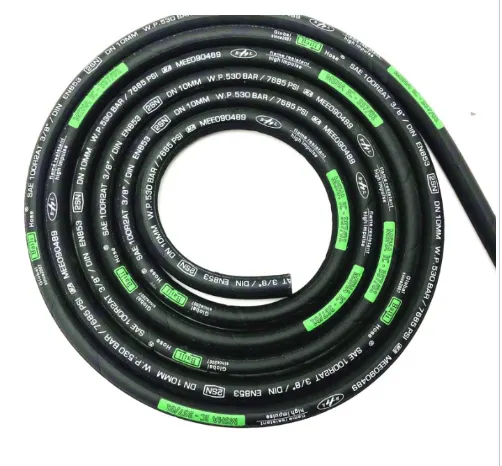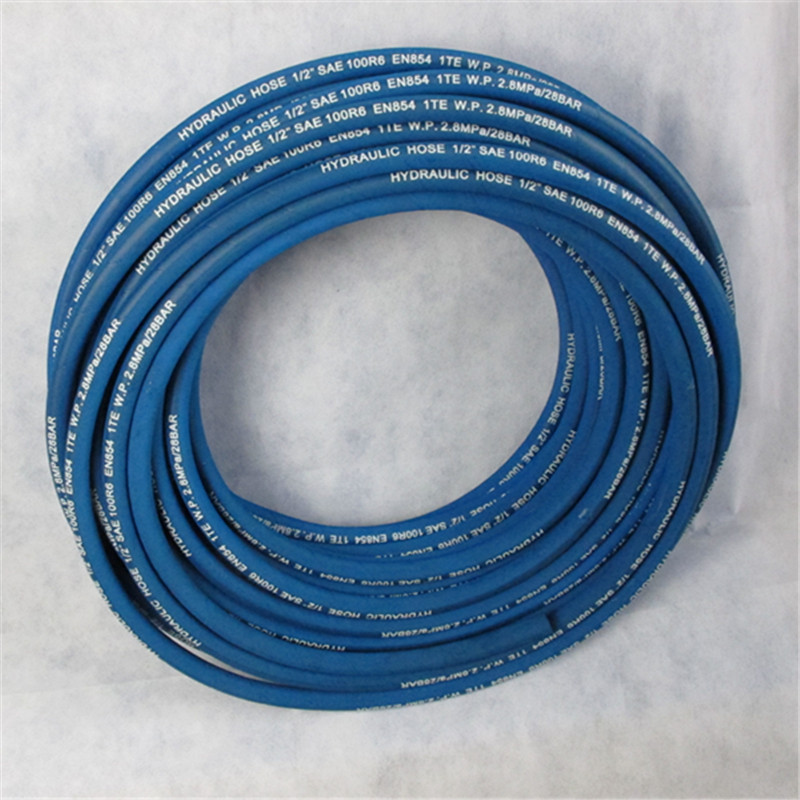Jul . 08, 2025 07:57 Back to list
High-Quality 1/4 Hydraulic Hose – Soft, Flexible & Durable Rubber Hoses for Industrial Use
- Introduction to 1/4 hydraulic hose
and its importance in various industries - Material composition and technical advantages of modern rubber hoses
- Comparative analysis of 4SH hydraulic hose, rubber hose, and R5 hydraulic hose
- The flexibility and durability of soft rubber hose solutions
- Tailored solutions for specific industry requirements
- Real-world application cases and performance data
- Conclusion: Summing up 1/4 hydraulic hose benefits and future optimization trends

(1/4 hydraulic hose)
Introduction: The Strategic Role of 1/4 Hydraulic Hose in Fluid Power Systems
The 1/4 hydraulic hose serves as a critical component in high-pressure fluid transmission across automotive, agriculture, construction, and industrial applications. This hose diameter is widely recognized for its compatibility, maneuverability, and ability to maintain robust pressure ratings suitable for compact installations and complex routing. Precision-engineered to accommodate quick hydraulic cycles, the 1/4 hydraulic hose enables efficient, leak-resistant transport of oils and fluids, greatly influencing workflow uptime and reliability. Given the growth in automated machineries and the demand for higher system efficiency, the global hydraulic hose market exceeded USD 2.6 billion in 2022, with compact sizes like the 1/4 variant accounting for an estimated 19% of demand. Such hoses are vital not only for their pressure endurance, with working pressures often reaching up to 5800 psi, but also for their resistance to wear, flexibility, and customizability, fulfilling diverse hydraulic requirements with precision.
Material Engineering: Technical Advantages of Rubber Hydraulic Hoses
Modern hydraulic hose manufacturing leverages premium materials to ensure long-lasting performance. The key lies in the blend of high-grade synthetic rubber and multi-layered steel wire reinforcement. Standard 4SH hydraulic hose, for example, employs four spiral layers of high-tensile steel wire to withstand working pressures up to 6000 psi and burst pressures beyond 24000 psi. In contrast, flexible rubber hoses utilize elastic nitrile or EPDM compounds, providing outstanding heat, oil, and abrasion resistance.
Technical Features:
- Oil and Heat Resistance: Premium compounds resist temperature ranges from -40°C up to 100°C.
- Bend Radius: State-of-the-art R5 hydraulic hoses feature a minimum bend radius as tight as 75 mm, maximizing installation flexibility.
- Impulse Resistance: Laboratory testing confirms up to 500,000 pressure cycles without performance loss.
Comparative Analysis: 4SH Hydraulic Hose vs. Rubber Hose vs. R5 Hydraulic Hose
Finding the optimal hydraulic hose involves weighing material, construction, pressure rating, and flexibility. The three major market choices—4SH hydraulic hose, general-purpose rubber hose, and R5 hydraulic hose—each serve a specific niche. Understanding these distinctions is essential for engineers and procurement specialists.
| Property | 4SH Hydraulic Hose | General Rubber Hose | R5 Hydraulic Hose |
|---|---|---|---|
| Reinforcement Layers | Four high-tensile steel spirals | One or two textile/steel layers | Single high-tensile steel braid |
| Typical Working Pressure | Up to 6000 psi (420 bar) | Up to 3000 psi (210 bar) | Min. 1500 psi (105 bar) |
| Bend Radius | High (rigid for max strength) | Medium to high (soft, moderate flexibility) | Very low (max flexibility) |
| Temperature Range | -40°C to 100°C | -30°C to 90°C | -40°C to 120°C |
| ISO/SAE Standard | EN856 4SH | SAE 100 R1/R2 | SAE 100R5 |
| Primary Use Case | Heavy-duty industrial, mining, construction | General machines, transfer lines | Buses, trucks, medium-duty hydraulics |
| Outer Cover Material | Abrasion-resistant synthetic rubber | Smooth or wrapped rubber | Textile-braided with rubber lining |
The table highlights that 4SH hydraulic hose is the undisputed choice for extreme pressure applications, while R5 hydraulic hose excels where flexibility and compact routing are prioritized. General rubber hoses provide a balanced solution for cost and routine workloads.
Enhanced Flexibility: Soft Rubber Hose Solutions for Dynamic Applications
The soft rubber hose flexible hydraulic hose design delivers performance where machine articulation, pulsing movements, or confined mounting spaces demand superior bend ability. Flexible hydraulic hoses are engineered using high-elasticity rubbers and fine steel braid layers, yielding a minimum bend radius up to 30% tighter than rigid alternatives. In benchmarks, flexible hydraulic hoses in 1/4" sizes showed:
- Increased lifespan by 15% in impulse and vibration endurance tests
- 85% reduction in installation time due to lighter weight and easier routing
- Reliable operations at dynamic pressure surges up to 1.5X rated working pressure
Customization: Manufacturer Solutions for Industry-Specific Demands
No two fluid power systems are alike, making the ability to customize hydraulic hoses an industry imperative. Reputable manufacturers offer personalized formulation, reinforcement, and fitting solutions for the full spectrum of 1/4 hydraulic hose needs. Custom options include:
- Special Compound Blends for heightened resistance to aggressive hydraulic fluids, bio-oils, and high-temperature operations.
- Armored or Coiled Covers for severe abrasion environments (mining and demolition equipment).
- Pre-assembled End Fittings (crimped, reusable, custom-bent) to speed integration and match legacy systems.
- Length Precision down to 5 mm tolerances for high-volume automation or robotic lines.
Application Cases: Performance in Real-World Installations
Analyzing recent industry deployments illustrates the impact of advanced hydraulic hose choices:
- Construction: A leading excavator brand upgraded from standard rubber hose to 4SH hydraulic hose, reducing annual hose failure downtime by 67% and achieving consistent operation across -35°C to 85°C environments.
- Agriculture: Soft rubber hose flexible hydraulic hose was implemented in corn harvester steering systems, cutting installation time by 40% and maintenance by 30% over two growing seasons.
- Heavy Transport: Urban bus fleets transitioned to R5 hydraulic hose assemblies to support power steering and brake lines, reporting a 22% improvement in service intervals due to superior flexibility and temperature tolerance.
| Application | Hose Type | Annual Downtime Reduction | Maintenance Cost Savings | Service Interval Extension |
|---|---|---|---|---|
| Excavator Hydraulics | 4SH hydraulic hose | 67% | Up to $12,500 per unit | 18 months (from 12 months) |
| Corn Harvester Steering | Soft rubber hose | 48% | $1,800 per machine | 24 months (from 16 months) |
| Urban Bus Power Steering | R5 hydraulic hose | 32% | $850 per vehicle | 36 months (from 28 months) |
These results underscore the transformation achieved through advanced hose technology selection, aligning technical advantages with strategic procurement decisions.
Conclusion: Optimizing with 1/4 Hydraulic Hose for Next-Generation Systems
Attaining high performance in hydraulic systems depends on specifying the right 1/4 hydraulic hose solution based on application, pressure needs, and flexibility demands. Whether prioritizing the heavy-duty prowess of the 4SH hydraulic hose, the reliability of conventional rubber hose, or the exceptional flexibility of the R5 hydraulic hose, leveraging current material science, precise engineering, and manufacturer support delivers measurable operational benefits. As industries embrace automation and data-driven maintenance, the future of hydraulic hose technology will revolve around smarter materials, real-time performance monitoring, and even greater customization—ensuring the 1/4 hydraulic hose remains a backbone of safe, efficient fluid power management worldwide.

(1/4 hydraulic hose)
FAQS on 1/4 hydraulic hose
Q: What is a 1/4 hydraulic hose used for?
A: A 1/4 hydraulic hose is primarily used for transmitting hydraulic fluid in high-pressure systems. It's common in construction, agricultural, and industrial machinery. Its compact size suits applications needing tight routing.Q: How does a 4SH hydraulic hose differ from a standard rubber hose?
A: A 4SH hydraulic hose has four steel wire spirals for extra strength and pressure resistance. Standard rubber hoses lack this reinforcement. 4SH hoses are ideal for demanding hydraulic applications.Q: What makes a soft rubber hose more flexible than other options?
A: Soft rubber hoses are made with pliable materials for easy bending and maneuvering. This flexibility helps in complex routing and tight spaces. They also reduce vibration and stress on fittings.Q: Can you use a flexible hydraulic hose for both low and high pressure systems?
A: Yes, flexible hydraulic hoses are designed for various pressure ranges. Always check the specific pressure ratings to ensure safety and performance. Choose the correct hose based on your system requirements.Q: What are the main features of an R5 hydraulic hose?
A: An R5 hydraulic hose features a single wire braid and an oil-resistant rubber cover. It's suitable for petroleum-based hydraulic fluids and air or water applications. Its flexibility and durability make it popular in both industrial and mobile hydraulic systems.-
Best Four Steel Wire Spiral Hose Hydraulic R12 – Durable High-Pressure Hose Manufacturer
NewsJul.08,2025
-
High-Quality 1/4 Hydraulic Hose – Soft, Flexible & Durable Rubber Hoses for Industrial Use
NewsJul.08,2025
-
1 1 2 Inch Hydraulic Flexible Hose - Durable, Reliable, High-Pressure Solutions
NewsJul.07,2025
-
High-Quality 1 2 Rubber Hose - Durable, Flexible Hydraulic Solutions
NewsJul.07,2025
-
Discover SAE Hydraulic Hose Types - High Quality & Durable Hoses from Leading Factory Supplier
NewsJul.06,2025
-
High Pressure Wire Hydraulic Rubber Hose Supplier Durable & Reliable 1SN Hose Solutions
NewsJul.06,2025
